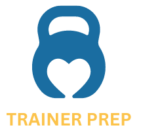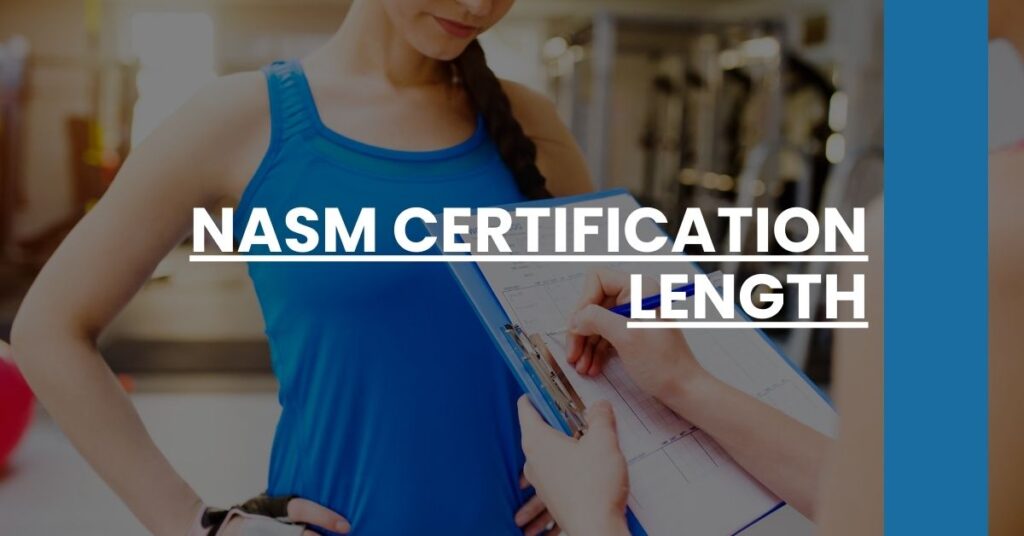The NASM certification length typically ranges from 8 to 15 weeks. This duration depends on factors like study habits and available time. Expect to spend 8-12 weeks if you study part-time or 4-8 weeks for a more intensive, full-time schedule.
In this article, you’ll find:
- Requirements for NASM certification
- Study plan and tips for efficient preparation
- Fast-track options for quicker completion
- Time commitment for recertification
Whether you’re balancing a busy schedule or aiming to fast-track your certification, this article will help you understand the time investment required.
Overview of NASM Certification Requirements
The NASM (National Academy of Sports Medicine) certification, particularly the Certified Personal Trainer (CPT) credential, stands as a leading choice among fitness professionals. If you’re considering this certification, it’s essential to understand the prerequisites and ongoing efforts needed to maintain this status.
Prerequisites for NASM Certification
To start, you need to meet a few key prerequisites:
- Educational Background: You must have a high school diploma or GED.
- CPR/AED Certification: You must hold current CPR/AED certification. This ensures that you can respond to emergency situations professionally and effectively.
Study Materials and Resources
NASM provides a wealth of study resources designed to help you succeed. These include:
- Textbooks: Core material covering exercise science, program design, and client interaction.
- Online Courses: Interactive, self-paced modules that provide both theoretical and practical knowledge.
- Practice Exams: These simulate the real exam environment, helping you gauge your readiness.
- Workshops and Live Events: For hands-on learning experiences and deeper understanding.
The NASM Certification Exam
The pathway to earning your NASM CPT credential culminates in passing a 120-question, multiple-choice exam. The exam covers a broad range of topics:
- Exercise Science: Understanding the mechanics, anatomy, and physiology behind fitness.
- Fitness Assessment: Knowing how to assess and create personalized fitness plans.
- Program Design: Creating safe and effective fitness programs based on individual client needs.
- Nutrition: Basic nutritional advice relevant to fitness goals.
A score of 70% or higher is required to pass this exam. Thorough preparation using NASM’s complete study materials will help you meet this goal.
Recertification Requirements
Once certified, you must maintain your credentials. NASM certification is valid for two years, requiring recertification before it expires. For renewal:
- Continuing Education Units (CEUs): Earn 20 CEUs within the two-year period through workshops, additional courses, or industry conferences.
- CPR/AED Certification Renewal: Ensure your CPR/AED certification remains current.
By fulfilling these requirements, you ensure your skills and knowledge stay relevant and up-to-date, benefiting both you and your clients.
Average Time to Complete NASM Certification
Whether you can commit a few hours each week or immerse yourself full-time, the duration to complete the NASM certification can vary:
Part-Time Study
For part-time candidates, balancing work or school commitments, completing the certification can take:
- 12 to 15 Weeks: Allocating 5-10 hours per week. This pace works well if you adhere to a consistent study schedule.
Full-Time Study
If you can focus on your studies less interruptedly, you’ll likely finish faster:
- 8 to 10 Weeks: Dedicating 20-30 hours per week can significantly shorten the preparation period.
Specialized Certifications
NASM also offers specialized credentials, like the Performance Enhancement Specialist (PES) or Corrective Exercise Specialist (CES):
- 8 to 12 Weeks: These advanced certifications often require a more intensive and focused study regimen.
Flexibility and Personalization
Remember, every individual’s situation is unique. The key here is flexibility. Tailor your study habits to what works best for you and adjust as needed to remain on track.
Factors Affecting the Duration of NASM Certification
Several elements can affect how long it takes for you to achieve your NASM certification:
Study Habits
Effective study habits can significantly impact your progress:
- Consistency: Regular, scheduled study times can help maintain momentum.
- Active Learning: Engaging with the material through quizzes or practical applications reinforces learning.
Prior Knowledge
Your background can either ease or complicate the study process:
- Relevant Background: A degree in exercise science or related fields can speed up your preparation.
- New to Fitness: Without a prior background, you might need more time to understand foundational concepts.
Available Time
Your personal and professional commitments dictate how much study time you can allocate:
- Balancing Act: Work, family, or school obligations might slow progress.
- Focused Time: Fewer distractions and more dedicated study periods expedite completion.
Quality of Study Materials
NASM’s resources are top-notch, but the choice and use of materials can affect your learning efficiency:
- Structured Study Plans: Clear, organized plans help maintain focus and cover necessary content systematically.
- Practice Exams: Regular practice using NASM-provided exams sharpens test-taking skills.
By understanding these factors, you can better gauge your timeline and adjust your approach to achieve NASM certification more efficiently.
The journey towards becoming a certified NASM personal trainer is comprehensive but manageable. Your commitment, effective study techniques, and consistent effort will determine your success.
For more in-depth guidance and useful study resources, explore our NASM preparation services.
Study Plan and Tips for Efficiently Completing NASM Certification
When you’re embarking on your NASM certification journey, having a structured study plan can make all the difference. It ensures that you cover all necessary material and stay on track to meet your certification goals, which is crucial given the average NASM certification length of 8 to 15 weeks.
Creating an Effective Study Schedule
A well-crafted study schedule helps you organize your time and focus your efforts effectively. Here’s how you can create a robust study plan:
- Set Clear Goals: Define what you want to achieve each week. Break down the certification content into manageable sections.
- Daily Study Time: Allocate specific hours each day or week for studying. Consistency aids retention and understanding.
- Use a Mix of Resources: Combine textbooks, online modules, and practice exams to gain a well-rounded understanding of the material.
Example Weekly Plan:
- Week 1-2: Focus on exercise science and the basics of human anatomy.
- Week 3-4: Dive into fitness assessment techniques and client interaction skills.
- Week 5-6: Study program design and nutrition fundamentals.
- Week 7-8: Take practice exams and review challenging concepts.
Utilizing NASM’s Study Resources
NASM provides high-quality study aids designed to prepare you thoroughly:
- Textbook: The “NASM Essentials of Personal Fitness Training” covers every topic you need to know.
- Online Courses: Interactive and flexible, these courses help you learn at your own pace.
- Practice Exams: These simulate the test environment, helping you identify areas where you need more review.
- Flashcards: Great for memorizing key terms and concepts.
Effective Study Techniques
Engage with the material actively to enhance retention and understanding:
- Active Reading: Take notes, highlight key points, and summarize sections in your own words.
- Practice Quizzes: Regular quizzes reinforce learning and help identify weak spots.
- Study Groups: Join or form study groups for collaborative learning and discussion.
- Interactive Learning: Participate in workshops or seminars to gain hands-on experience and insights.
Staying Motivated and On Track
Balancing study with other commitments can be challenging. Here are some tips to stay motivated:
- Visualize Success: Keep your end goal in mind—becoming a certified personal trainer.
- Reward System: Set milestones and reward yourself when you achieve them.
- Stay Organized: Use planners or digital apps to keep track of your study schedule and deadlines.
- Healthy Lifestyle: Regular exercise, balanced nutrition, and adequate rest can greatly improve your study efficiency.
For more resources and structured study advice, visit our guide on NASM Certification.
Fast-Track Options for NASM Certification
If you’re eager to complete your NASM certification quickly, fast-track options can help you achieve your goal in a shorter timeframe.
Exploring Accelerated Programs
Several accelerated NASM programs are available, designed for those with substantial time to dedicate daily to their studies:
- Boot Camps: Intensive study sessions held over several weeks, covering all exam material thoroughly.
- Condensed Learning Modules: Short-term courses focusing on key concepts, often supplemented with online resources for flexible learning.
Self-Paced Online Programs
NASM offers self-paced, online certification programs that you can complete at your own speed:
- Flexible Schedules: Study when it fits into your life. This can be particularly helpful if you have variable commitments.
- Comprehensive Material: Access resources that cover all required content for the exam.
- Practice Tests: Regularly test your knowledge to ensure you’re on track.
Intensive Study Tips
For those opting for a fast-track route, here are some intensified study tips:
- Daily Study Goals: Set specific targets for what you need to achieve each day.
- Deep Focus Sessions: Use techniques like the Pomodoro Technique for intense study periods with short breaks.
- Immediate Review: Regularly test yourself on what you’ve just studied to reinforce knowledge.
Balancing Speed with Comprehension
While it’s tempting to rush, ensure you fully understand the material:
- Thorough Understanding: Focus on truly mastering each topic rather than just skimming through.
- Practical Application: Engage with practical scenarios and real-world examples to deepen your understanding.
Fast-tracking requires discipline and commitment but can be efficient if you are focused and resourceful. For more on accelerating your NASM certification, check out our fast certification options.
Time Commitment for NASM Recertification
Once you’ve achieved your NASM certification, staying current involves periodic recertification. Here’s what you need to know about the time commitment required:
Earning Continuing Education Units (CEUs)
Your NASM certification is valid for two years, and to maintain it, you must earn 20 continuing education units (CEUs) during this period:
- Workshops and Seminars: Participating in industry-related events can offer CEUs.
- Online Courses: Easily accessible and can be completed at your own pace.
- Work Experience: Gaining practical experience through work can sometimes count towards CEUs.
Scheduling and Planning for CEUs
To avoid last-minute rushes, plan your CEU activities well in advance:
- Annual Targets: Aim to complete at least 10 CEUs each year to distribute the load evenly.
- Select Relevant Topics: Focus on courses that interest you or add the most value to your career.
- Track Progress: Keep a log of all CEU activities and the points earned.
Renewing CPR/AED Certification
Your CPR/AED certification must also be current for recertification:
- Regular Updates: Schedule sessions to renew your CPR/AED certification every two years.
- Combination Courses: Some workshops offer CEUs along with CPR/AED renewal, making it efficient to earn recertification points.
Balancing Work and Recertification
Maintaining certification can seem challenging when you’re working:
- Integrate Learning: Choose CEUs that coincide with areas you’re already working on.
- Efficient Learning: Opt for online courses or workshops that fit your schedule.
Being proactive with your CEU activities ensures you stay compliant and continue to offer the highest standards of personal training. For more on maintaining your certification, visit our NASM recertification guide.
Conclusion
The duration to complete NASM certification depends on various factors. On average, you can expect it to take 8 to 15 weeks. However, with a tailored study plan, efficient use of resources, and dedication, you can manage your time effectively to achieve certification. Recertification requires commitment to continuing education, ensuring you stay current in the ever-evolving field of fitness.
Take the next step in your fitness career by planning your certification journey and leveraging available resources. For more detailed information, explore our comprehensive guide to NASM Certification.

